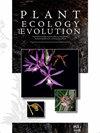Molecular phylogeny and character-mapping support the synonymy of Cordobia and Gallardoa in Mionandra (Malpighiaceae)
IF 1.3
4区 生物学
Q3 PLANT SCIENCES
引用次数: 0
Abstract
Background and aims – Cordobia, Gallardoa, Mionandra, and Peixotoa (Stigmaphylloid clade, Malpighiaceae) are four small, closely related genera comprising shrubs or lianas endemic to South American savannas, dry forests, and temperate steppes. Their generic limits have significantly changed in the last century, and past molecular phylogenetic studies of Malpighiaceae have not tested the morphological characters of this group to identify synapomorphies supporting these clades/genera. Material and methods – We sampled the monospecific Cordobia and Gallardoa, one species of Mionandra (out of 2 spp.), nine species of Peixotoa (out of 29 spp.), and a single species of Camarea and Janusia as outgroups. Bayesian and Maximum Likelihood analyses were carried out for this clade based on five molecular markers (i.e. ETS, ITS, PHYC, matK, and ndhF). A set of 16 macromorphological characters was scored and coded for identifying synapomorphies under the Maximum Likelihood criteria. Key results – Our molecular phylogeny recovered Peixotoa as monophyletic and sister to the clade comprising Cordobia + Gallardoa + Mionandra, strongly corroborating previous phylogenetic studies of Malpighiaceae. The character-mapping analyses recovered two synapomorphies supporting the Cordobia + Gallardoa + Mionandra + Peixotoa clade, six supporting Mionandra s.l. (i.e. Cordobia + Gallardoa + Mionandra), and five supporting Peixotoa. Cordobia and Gallardoa are proposed as synonyms of Mionandra, alongside the necessary combinations, typifications, and identification keys. Conclusions – Morphological characters related to the degree of connation of the stipules, leaf indumentum type, petiole length, inflorescence architecture, number of flowers per inflorescence, presence of a peduncle in the 1-flowered cincinni, sepal connation, posture and texture, petal width and margin integrity, staminode presence, shape and size, and the shape of the apex of styles were key in circumscribing these lineages. Mionandra s.l. is proposed and characterised, including a new combination, an identification key to distinguish its species, a distribution map, and taxonomy notes.分子系统发育和特征定位支持了龙葵科植物Cordobia和Gallardoa的同义性
背景和目的:Cordobia、Gallardoa、Mionandra和Peixotoa(麻豆科)是南美洲热带稀树草原、干燥森林和温带草原特有的四个小型、密切相关的灌木或藤本植物属。它们的属界在上个世纪发生了显著的变化,过去的马尔匹吉科分子系统发育研究没有测试这一类群的形态特征,以确定支持这些分支/属的突触形态。材料与方法:本研究以单种Cordobia和Gallardoa、1种Mionandra(2种)、9种Peixotoa(29种)和1种Camarea和Janusia作为外群。基于5个分子标记(即ETS、ITS、PHYC、matK和ndhF)对该进化支进行了贝叶斯和最大似然分析。在最大似然标准下,对一组16个大形态特征进行评分和编码,以识别突触形态。我们的分子系统发育恢复了Peixotoa是单系的,是由Cordobia + Gallardoa + Mionandra组成的分支的姐妹,有力地证实了之前对malpiighiaceae的系统发育研究。特征定位分析发现,支持Cordobia + Gallardoa + Mionandra + Peixotoa支系的共2个,支持Mionandra s.l(即Cordobia + Gallardoa + Mionandra)的共6个,支持Peixotoa的共5个。Cordobia和Gallardoa被提议作为Mionandra的同义词,以及必要的组合、分类和识别键。结论:与托叶构成程度、叶被类型、叶柄长度、花序结构、每花序花数、单花蝎尾花中是否存在花序梗、萼片构成、姿态和质地、花瓣宽度和边缘完整性、雄蕊存在、形状和大小以及花柱顶端形状相关的形态学特征是界定这些谱系的关键。摘要提出了一种新组合、一种鉴别钥匙、一幅分布图和分类学注释。
本文章由计算机程序翻译,如有差异,请以英文原文为准。
求助全文
约1分钟内获得全文
求助全文
来源期刊

Plant Ecology and Evolution
PLANT SCIENCES-
CiteScore
2.20
自引率
9.10%
发文量
27
审稿时长
>12 weeks
期刊介绍:
Plant Ecology and Evolution is an international peer-reviewed journal devoted to ecology, phylogenetics and systematics of all ‘plant’ groups in the traditional sense (including algae, cyanobacteria, fungi, myxomycetes), also covering related fields.
The journal is published by Meise Botanic Garden and the Royal Botanical Society of Belgium.
 求助内容:
求助内容: 应助结果提醒方式:
应助结果提醒方式:


